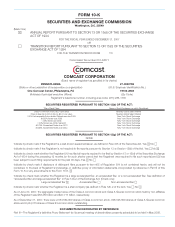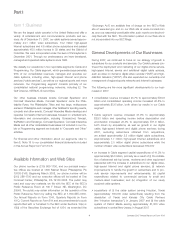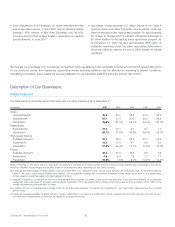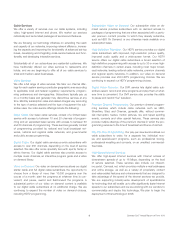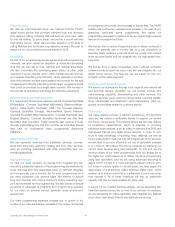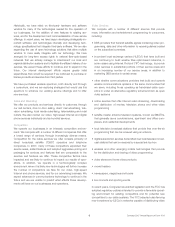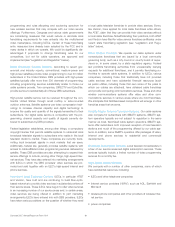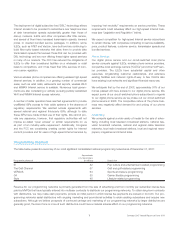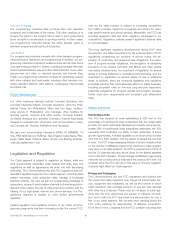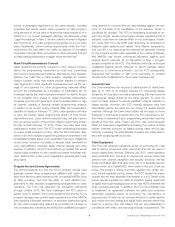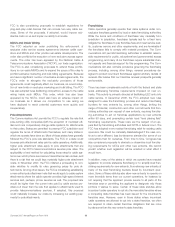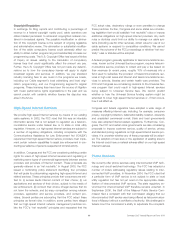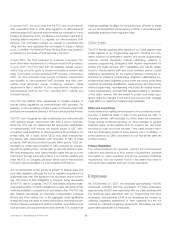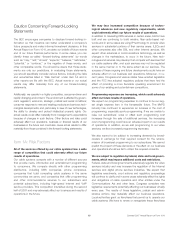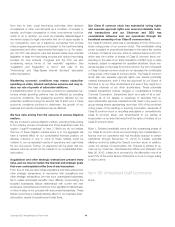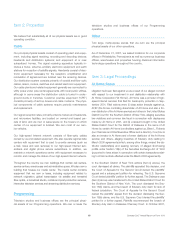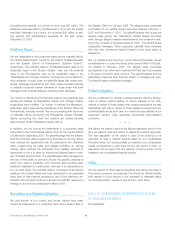Comcast 2007 Annual Report Download - page 8
Download and view the complete annual report
Please find page 8 of the 2007 Comcast annual report below. You can navigate through the pages in the report by either clicking on the pages listed below, or by using the keyword search tool below to find specific information within the annual report.programming and rules allocating and auctioning spectrum for
new wireless services that may compete with our video service
offerings. Furthermore, Congress and various state governments
are considering measures that would reduce or eliminate local
franchising requirements for new entrants into the multichannel
video marketplace, including ILECs. Certain of these franchising
entry measures have already been adopted by the FCC and in
many states in which we operate. We could be significantly dis-
advantaged if proposals to change franchising rules for our
competitors, but not for cable operators, are approved and
implemented (see “Legislation and Regulation” below).
Direct Broadcast Satellite Systems. According to recent gov-
ernment and industry reports, conventional, medium-power and
high-power satellites provide video programming to over 30 million
subscribers in the United States. DBS providers with high-power
satellites typically offer more than 300 channels of programming,
including programming services substantially similar to those our
cable systems provide. Two companies, DIRECTV and EchoStar,
provide service to substantially all of these DBS subscribers.
High-power satellite service can be received throughout the con-
tinental United States through small rooftop or side-mounted
outdoor antennas. Satellite systems use video compression tech-
nology to increase channel capacity and digital technology to
improve the quality and quantity of the signals transmitted to their
subscribers. Our digital cable service is competitive with the pro-
gramming, channel capacity and quality of signals currently de-
livered to subscribers by DBS providers.
Federal legislation establishes, among other things, a compulsory
copyright license that permits satellite systems to retransmit local
broadcast television signals to subscribers who reside in the local
television station’s market. These companies are currently trans-
mitting local broadcast signals in most markets that we serve.
Additionally, federal law generally provides satellite systems with
access to cable-affiliated video programming services delivered by
satellite. These DBS providers are also attempting to expand their
service offerings to include, among other things, high-speed Inter-
net services. They have also entered into marketing arrangements
with ILECs in which the DBS providers’ video services are pro-
moted and sold together with an ILEC’s high-speed Internet and
phone services.
Incumbent Local Exchange Carriers. ILECs, in particular AT&T
and Verizon, have built and are continuing to build fiber-optic-
based networks to provide video services in substantial portions of
their service areas. These ILECs have begun to offer video services
in an increasing number of our service areas and, in certain areas,
video services are being offered in addition to joint marketing
arrangements ILECs have entered into with DBS providers. ILECs
have taken various positions on the question of whether they need
a local cable television franchise to provide video services. Some,
like Verizon, have applied for local cable franchises while others,
like AT&T, claim that they can provide their video services without
a local cable franchise. Notwithstanding their positions, both AT&T
and Verizon have filed for video service franchise certificates under
recent state franchising legislation (see “Legislation and Regu-
lation” below).
Other Wireline Providers. We operate our cable systems under
nonexclusive franchises that are issued by a local community
governing body, such as a city council or county board of super-
visors or, in some cases, by a state regulatory agency. Federal
law prohibits franchising authorities from unreasonably denying
requests for additional franchises, and it permits franchising au-
thorities to operate cable systems. In addition to ILECs, various
companies, including those that traditionally have not provided
cable services and have substantial financial resources (such
as public utilities, including those that own some of the poles to
which our cables are attached), have obtained cable franchises
and provide competing communications services. These and other
wireline communications systems offer video and other com-
munications services in various areas where we hold franchises.
We anticipate that facilities-based competitors will emerge in other
franchise areas that we serve.
Satellite Master Antenna Television Systems. Our cable systems
also compete for subscribers with SMATV systems. SMATV sys-
tem operators typically are not subject to regulation in the same
manner as local, franchised cable system operators. SMATV sys-
tems offer subscribers both improved reception of local television
stations and much of the programming offered by our cable sys-
tems. In addition, some SMATV operators offer packages of video,
internet and phone services to residential and commercial
developments.
Broadcast Subscription Services. Local television broadcasters in
a few of our service areas sell digital subscription services. These
services typically include a limited number of video programming
services for a monthly fee.
High-Speed Internet Services
We compete with a number of other companies, many of which
have substantial resources, including:
• ILECs and other telephone companies
• Internet service providers (“ISPs”), such as AOL, Earthlink and
Microsoft
• wireless phone companies and other providers of wireless Inter-
net service
• power companies
Comcast 2007 Annual Report on Form 10-K 6

